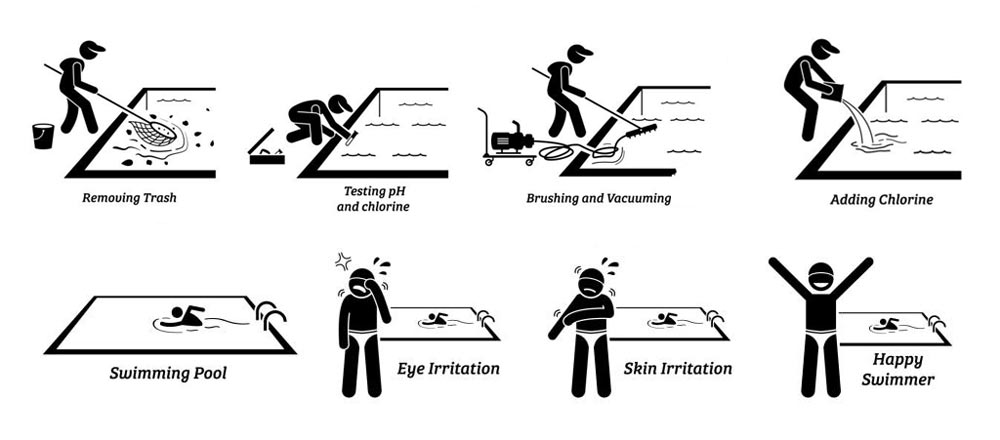
En tant queFournisseur de produits chimiques de piscine, on nous pose souvent une question: "Pouvez-vous mettre du chlore directement dans une piscine?". Cette question semble simple, mais il y a beaucoup de connaissances sur le traitement de l'eau de la piscine cachée derrière.
Pourquoi le chlore ne peut-il pas être placé directement dans la piscine?

La réponse est simple: si vous utilisez l'hypochlorite de calcium (CHC), car le CHC contient beaucoup de matière insoluble, le dosage direct entraînera une turbade de l'eau de la piscine et beaucoup de précipitations seront produites au fond de la piscine.
De plus, si leDésinfectantVous utilisez dans la piscine de doublure en plastique est des granules SDIC, des granules TCCA et de la poudre, car ils prennent un certain temps à dissoudre, les particules qui tombent sur la doublure corroderont ou blanchiront la doublure. Même les granules SDIC les plus rapides le feront.
Et si vous le mettez directement, la concentration de chlore libre dans l'eau ne sera pas aussi uniforme que si elle est ajoutée après le dosage. Il faut plus de temps pour permettre au chlore libre de répartir uniformément dans l'eau de la piscine.
Une fois la poussière générée, elle causera des dommages à la peau ou respiratoire du mainteneur de la piscine.
La bonne façon d'ajouter du chlore

Il existe de nombreux types de désinfectants adaptés aux piscines. Par exemple: chlore liquide, hypochlorite de calcium, dichloroisocyanurate de sodium et acide trichloroisocyanurique. Alors, comment devrions-nous ajouter correctement le chlore à la piscine? La méthode de chloration correcte est principalement déterminée par la forme et les caractéristiques du désinfectant du chlore. Il y a principalement ce qui suit:
Chlore granulaire:Il doit être dissous dans un seau d'eau avant de l'ajouter à la piscine.
Comprimés de chlore:Les comprimés de chlore sont un désinfectant de chlore solide, généralement des comprimés TCCA. Mettez les comprimés de chlore dans un flotteur ou des mangeoires, et les comprimés de chlore se dissolveront lentement et libèrent du chlore. Cette méthode est simple à utiliser, mais le taux de libération du chlore est lent, et la quantité de comprimés de chlore doit être ajustée en fonction de la taille de la piscine et de la qualité de l'eau.
Chlore liquide:Le chlore liquide doit être dilué et ajouté à l'eau de la piscine lorsqu'il est utilisé.
Précautions de chloration

Peu importe la méthode de chloration utilisée, vous devez faire attention aux points suivants:
Ajustez la quantité de chlore ajoutée en fonction de la qualité de l'eau:La matière organique, les algues et autres impuretés dans l'eau de la piscine consommeront le chlore, de sorte que la quantité de chlore ajoutée doit être ajustée en fonction de la qualité de l'eau. Déterminez si l'élimination des algues, les objets flottants et le choc sont nécessaires.
Tester régulièrement le chlore résiduel:Le chlore libre est un indicateur clé pour assurer l'effet de désinfection de l'eau de la piscine. La teneur efficace du chlore doit être testée régulièrement pour s'assurer qu'elle reste dans une plage raisonnable.
Faites attention à la ventilation:Lors de l'ajout de chlore, faites attention à la ventilation, maintenez l'air qui coule et évitez une concentration excessive de chlore.
Évitez le contact direct avecdésinfectants du chlore:Lors de l'ajout de désinfectants, des gants de protection, des masques et d'autres équipements de protection doivent être portés pour éviter le contact direct.
L'ajout de chlore directement à la piscine n'est pas une pratique recommandée, ce qui peut affecter l'efficacité du chlore efficace et provoquer des problèmes de qualité de l'eau. Cela entraînera également des dommages à la doublure ou au matériel de piscine. La méthode de chloration correcte est un élément important pour assurer la sécurité de la qualité de l'eau de la piscine. Le choix d'un fournisseur de produits chimiques de la piscine professionnelle peut vous aider à mieux maintenir la qualité de l'eau de la piscine et à profiter d'une expérience de natation saine.
En tant que professionnelFournisseur de produits chimiques de la piscine, Xingfei s'est engagé à fournir aux clients des produits et services de haute qualité. Si vous avez des questions sur le traitement de l'eau de la piscine, n'hésitez pas à nous contacter!
Heure du poste: oct-08-2024
